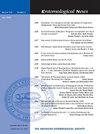Impact of Some Gamma-Irradiated Hosts on Bracon Brevicornis Wesmael Parasitism and Production
IF 0.3
4区 农林科学
Q4 ENTOMOLOGY
引用次数: 0
Abstract
ABSTRACT: The purpose of this study was to evaluate how irradiated hosts affected the mass rearing of the ectoparasitoid Bracon brevicornis Wesmael. To investigate the development of B. brevicornis stages on three hosts; full-grown larvae of Pectinophora gossypiella, Galleria mellonella, and Spodoptera litoralis were irradiated with 100, 200, and 300 Gy. The use of 100Gy in irradiating P. gossypiella and G. mellonella produced utilization in promoting parasitism and adult emergence of B. brevicornis, with parasitism percentages of 77.00% and 80.00% for P. gossypiella and G. mellonella, respectively, when compared to control larvae or other irradiated doses. The results of the biochemical experiments showed that G. mellonella > P. gossypiella > S. littoralis was the order of the insects in terms of total protein, lipids, and glucose. It could be concluded that using 100Gy irradiated P. gossypiella and G. mellonella larvae would aid in improving B. brevicornis mass production and the effectiveness of B. brevicornis.部分γ辐照寄主对短尾短尾轮虫寄生和生产的影响
摘要:本研究的目的是评估辐照宿主对体外寄生短角短臂虫大规模饲养的影响。研究短角孢在三个寄主上的发育过程;分别用100Gy、200Gy和300Gy照射棉蚜(Pectinophora gossypiella)、意大利夜蛾(Galleria mellonella)和草地贪夜蛾(Spodoptera litoralis,当与对照幼虫或其他辐照剂量相比时。生化实验结果表明,在总蛋白、脂类和葡萄糖含量方面,梅洛内拉>棉蚜>小金龟子依次为:。结果表明,用100Gy辐照棉蚜和梅洛内拉幼虫有助于提高短角孢杆菌的大规模生产和短角孢菌的有效性。
本文章由计算机程序翻译,如有差异,请以英文原文为准。
求助全文
约1分钟内获得全文
求助全文
来源期刊

Entomological News
生物-昆虫学
CiteScore
1.10
自引率
25.00%
发文量
17
期刊介绍:
Contributions are accepted on any of the aspects of systematics and taxonomy of insects. This includes: taxonomic revisions, phylogenetics, biogeography and faunistics, and descriptive morphology of insects. Taxonomic papers describing single species are acceptable if such a study is sufficiently justified, however, comprehensive studies that provide a comparative, integrated study of insect systematics and taxonomy will get priority.
 求助内容:
求助内容: 应助结果提醒方式:
应助结果提醒方式:


